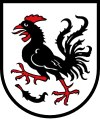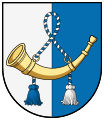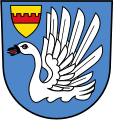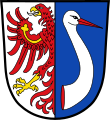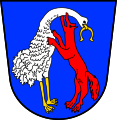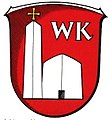Talking coat of arms
As a speaking coat of arms ( French always used in the plural armes parlantes ), also speaking coat of arms or name coat of arms , one describes in heraldry such coats of arms , which in the case of family names on the name of the owner or in the case of local coats of arms on the (often folk etymological ) interpretation of the Either allude to the place name or depict it like a rebus . The allusion is mostly in the figure, less often in the color.
Talking signs already existed in antiquity. The motifs of the coins from the archaic period , which are not yet inscribed, often refer to the names of the cities in which they were minted. Examples are Phokaia with a seal (Greek phokä ), Zankle ( zánklä = sickle), Himera with a rooster ( häméra = day) and Selinus with the leaf of a sickle tree ( sélinon = celery tree ), Melos with an apple (melon), Rhodes with a rose blossom (rhodon) . Some coins from the time of the Roman Republic allude to the family names of the mint masters with speaking symbols.
Examples
- Examples of talking coats of arms
City of Munich : the monk stands for Munich
Canton Uri ( Switzerland ): the auroch stands for Ur or Uri
Kröpelin : a creeping cripple
Bärnbach , the syllables say it
as in Hahnbach
The rooster also speaks in Haan
Horn (Lower Austria) : The Hifthorn stands for the town of Horn
Pfaffenhofen shows a priest tonsure , the Pfaffe can also be recognized accordingly in Pfaffstätten
Schwanau : A swan swimming in the floodplain
In Blaufelden the background and the brave sower talk
Cham : Has a crest in the coat of arms, although etymologically not related
Schweinspoint : There has been a boar here since the 12th century
Without words - Bad Säckingen
Hostage wind : The scourge hurts and the wind blows, symbolized by the wind dog
The cranesbill symbolizes woad in Upper Franconia
Lederhose (Thuringia) : This coat of arms was specifically adapted
Wildemann : city arms with wild man and Sachsenross
Fir ( Saxony-Anhalt ): Three conifers as a reference to the place name
Farners ( Canton Bern ) does the same thing
Vohe = vixen in Vohenstrauss
Guards in waxedt
Washing in Wäschenbeuren
Weißkirchen im Taunus
Henneberg (Meiningen) hen on (three) mountain
Küsnacht : folk etymological reference of the place name to Middle High German küssîn or Swiss German Chüssi "pillow"
Faoug (German peacock ): folk etymological reference of the place name to “peacock” and correct derivation from Latin fagus “beech”
Füllinsdorf : folk etymological reference of the place name to "Fohlen" or, in Swiss German, Fülli
Hranice u Aše (German Roßbach )
Otterbach , Germany
Otterndorf , Germany
Hadersdorf Chambers , Austria
Oxford or Ochsenfurt
The Counts of Henneberg led z. As a hen on a three-mountain, the men of Aufenstein one on or eagle owl, the House of Helfenstein an elephant; the coat of arms of the Lords of Olvenstedt shows a camel, which was called Olfent in the Middle Ages . There was a phonological similarity here. The later official heraldry proceeded in the choice of the speaking coats of arms very arbitrarily and contrary to the laws of the heraldry. The coat of arms of the Prussian Minister of State August Friedrich von Boden (ennobled in 1739) speaks three ways, in that it contains a paw, a base and a messenger.
Local coats of arms can also be meaningful , for example in Berlin (folk etymologically reinterpreted as little bear = little bear) or Bern (also folk based on bear ) and Hamburg (castle on a red background). In Uri is the Ur, an aurochs in Füllinsdorf to a foal (Swiss German Fülli; however, etymologically is a male personal name before). Another example is Tragwein (wine barrel on a stretcher). Falcons can often be found in the coats of arms of places called Falkenstein and Falkenberg (as in today's Niemodlin ), the lion in the community of Löwenberger Land , axes that hammer this in Beilstein , and a fir tree on coins and the coat of arms of the Alsatian city of Thann . Also known are the maid above the castle in the Magdeburg coat of arms or the Stralsunder ray .
Talking coats of arms were also used as mintmaster's mark. For example, Ernst Peter Hecht, mint master of the Leipzig mint from 1693 to 1714 , had the letters EPH and the pike from his coat of arms.

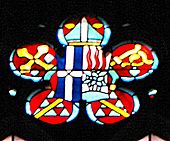
Many coats of arms are a (partly folk etymological) direct pictorial implementation of the place name:
- Lyon shows a lion; french lion = lion
- Tours shows three silver towers; french tour = tower
- Châteaurenard shows a castle under a fox; french château = castle , renard = fox
- Wolfsburg shows a wolf on a castle wall
- Steinhaus (Upper Austria) shows a stone house
- Neunkirchen (Lower Austria) shows nine churches
- Offenhausen in Austria shows a monkey on a half-open city gate
- Oxford shows an ox standing in the river; engl. ox = ox , ford = ford
- L'Aquila shows an eagle; ital. aquila = eagle
- Cambridge shows, among other things, a ship next to a bridge; engl. bridge = bridge over the river Cam
- Elmbridge shows an elm tree on a bridge; engl. elm = elm , bridge = bridge
- Eriskirch shows a golden iris ( Iris sibirica ) and today's parish church "Our Lady".
- Puchheim shows crossed p uchen leaves and a house
- Haßfurt shows a hare
- Meersburg shows a sea (Lake Constance) and a castle
- Goldscheuer shows a golden barn
- Königsbrunn shows the crown and the well shaft
- Bockhorn shows a buck and a wind instrument
- Nonnenhorn shows a nun and a horn of plenty
- Rockenhausen shows three ears of rye
- Beilstein (Württemberg) shows the Beilstein coat of arms with three (2: 1) pointed hammers carved into it on a stone
- Starnberg shows a starling on a green ground that looks like a bush, tree or hill. But there is also the research opinion that Starnberg does not get its name from Star , but from the root word Sta- (Gestade, Ufer ).
- Faoug , German peacock, has a peacock (folk etymological interpretation of the place name) and a beech (correct derivation from Latin fagus "beech") in the coat of arms
- Küsnacht and Küssnacht have a pillow in their coat of arms (folk etymological interpretation of the place name, but actually going back to fundus Cossiniacus , "country estate of Cossinius")
- The beech in Dürrenbüchig is dry (= leafless)
Other coats of arms use a symbolic "detour":
- Kröpelin shows a cripple; in fact, it is based on the Slavic word crepelice (= place of the quail).
- Lauffen am Neckar has the running messenger ("runner").
- Bettendorf (originated from Betendorf ) shows the Bible and rosary as a symbol for prayer.
- Telgte (after a Telgoth homestead) shows a stylized oak , Telge stands for oak ( Telgen Potten for planting trees, 16th century).
- Frankfurt (Oder) shows a rooster, lat. Gallus . In medieval Latin, the galli are Franks ("Gauls").
- Gallipoli shows a rooster, ital.gallo , although the name of the city actually comes from the Greek kalòs (folk etymology)
- Luckau shows a bull, the symbol for the evangelist Luke.
- Jüterbog shows a goat which, according to a folk etymology, is said to be the namesake
- Lichtental , the part of the 9th district of Vienna, shows a valley illuminated by the sun.
- Baden (Lower Austria) shows - bathers!
- Kindberg in Styria emblazoned as follows: "In a blue shield golden a naked child, sitting on a silver mountain, clad only in a loincloth, playing under three semicircular arranged golden five-pointed stars with one of the silver flowers growing out of the mountain in front and back."
- Schattendorf - casts shadows
Initial coat of arms
The initial coats of arms are also often seen as speaking. Examples are:
- Radome in Poland an "R" under a crown
- Kielce in Poland "CK" for "Civitas Kielce"
- Kraslice in the Czech Republic with a coat of arms-filling "G", which stood for the German name Graslitz until 1945
- Zittau in Saxony with a silver “Z” in the middle of the coat of arms
literature
- Gert Oswald : Lexicon of Heraldry. Bibliographical Institute, Mannheim / Vienna / Zurich / Leipzig 1984, ISBN 3-411-02149-7 ; 2nd unchanged edition with the subtitle Von Apfelkreuz bis Zwillingsbalken, Battenberg, Regenstauf 2006, ISBN 3-86646-010-4 ; 3rd edition 2011, ISBN 978-3-86646-077-5 .
- Winfried Schich : Talking seals of Brandenburg and other German cities in the 13th and 14th centuries. In: Markus Späth (ed.): The imagery of corporate seals in the Middle Ages. Art history and history in conversation (= Sensus. Vol. 1). Böhlau, Cologne a. a. 2009, ISBN 978-3-412-20353-5 , pp. 113-130.
Remarks
- ^ Haymann, Collecting Ancient Coins, Regenstauf 2016, pp. 29, 32
- ^ Peter Franz Mittag, Greek Numismatics, Heidelberg 2016, page 22
- ^ Rainer Albert, The Coins of the Roman Republic, Regenstauf 2003, catalog numbers 874, 905, 1117, 1241, 1298 and 1464
- ↑ Actually, the wall with gate and towers is the general coat of arms symbol for a city. In Hamburg, however, this usual symbol is huddled together like a castle.
- ↑ Star as namesake - a historical mistake? , merkur-online.de






